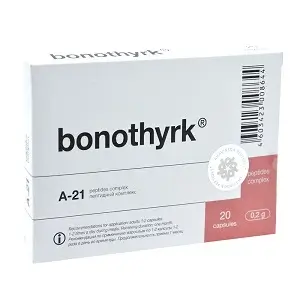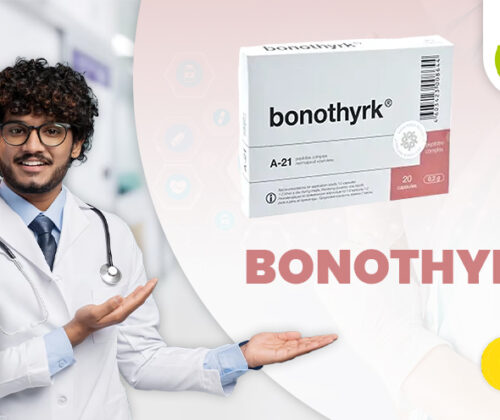
What is Bonothyrk Peptide and Why is it Used?
A complex of peptides called bonothyrk was isolated from the parathyroid glands of young, healthy animals. The isolated parathyroid gland peptides selectively affect different parathyroid gland cells in humans, take part in their cellular metabolism, and help control how well the parathyroid glands work.
The health of the parathyroid glands’ cells affects the human body’s ideal calcium balance. The cells must have an optimal supply of nutrients, including vitamins, minerals, and peptides, in order for them to function at their best. The peptides, which are parts of protein molecules and are released during protein metabolism (peptides = protein fragmentation into smaller parts) The peptides are informational molecules that control gene expression and trigger the synthesis of new proteins.Protein synthesis is an essential process. This is essential for cell growth and the execution of its primary functions.
The parathyroid glands’ peptides are formed in sufficient amounts in the young body. In cases where the body is under more stress, and unfortunately as we age, our bodies produce less protein. This means that as we age or as the conditions under which the parathyroid glands function become more severe, our bodies produce fewer parathyroid peptides, which has the effect of lowering the intensity of protein synthesis. The parathyroid glands’ peptide deficiency causes malfunctions in their tissue cells and may also result in the loss of some of these cells’ functions. The directed support provided to parathyroid gland cells in such circumstances is beneficial.
Using peptides from animal-derived parathyroid gland tissue is one of the best ways to compensate for the lack of parathyroid gland peptide. All mammals have the same peptides, which the human body recognises as endogenous substances (body substances). The peptides also possess characteristics unique to different tissues. They only function in the tissue where they were first isolated.
The parathyroid gland extract Bioregulator Bonothyrk contains all of the crucial parathyroid gland peptides. Only parathyroid gland tissue from calves and pigs under the age of 11 months is used for the extraction of peptides. All young animals come from farms where no cases of human-threatening illnesses, such as BSE, have been reported.
The body’s pool of regulatory peptides from the parathyroid gland tissue is enriched as a result of the use of the bioregulator Bonothyrk. As a result, using the bioregulator Bonothyrk peptide helps to normalize the peptide levels in the cells of the parathyroid glands. In turn, this results in the cells of the parathyroid glands’ metabolism returning to normal and controlling their operations. Inhibiting the growth of atrophic processes, reducing the risk of pathological development in the parathyroid glands, and supporting the normalization of parathyroid gland functions are all benefits of using the preparation.
DESCRIPTION OF PRODUCTS
In a clinical study, the effectiveness of the food supplement “Bonothyrk” was determined. It is effective for restoring the parathyroid glands’ functional activity when they have been compromised by conditions with different etiologies, such as hyperparathyroidism, osteoporosis, demineralization of bone tissue, urolithiasis, and muscle weakness, as well as hypoparathyroidism, which can cause hypocalcemia, muscular spasms, and muscle numbness.
Clinical studies on Bonothyrk
A clinical trial demonstrated the bioregulator Bonothyrk’s efficacy. This medication is efficient in supporting parathyroid function in conditions of various etiologies, including osteoporosis, hyperparathyroidism (overactivity of the parathyroid glands), demineralization of bone tissue, urolithiasis, muscle weakness, and hypoparathyroidism, as well as in conditions involving muscle cramps and stiffness and aging. There were no negative side effects.
Recommended:
osteoporosis, demineralization of bone tissue, urolithiasis, muscle weakness brought on by parathyroid gland hyperplasia, muscular spasms, and hypocalcemia-induced muscle numbness.
Ingredients
Parathyroid peptide complex A-21, microcrystalline cellulose (E460, the flowing agent), gelatin (the encasing agent), lactose (the excipient-humectant), and calcium stearate are the ingredients (E470, emulsifier).
Doses
Two capsules containing 20 mg of the A-21 peptide complex constitute the daily dose.
Apply here: Adults 1 to 2 capsules every meal, 1-2 times per day. The course lasts one month.
BIOREGULATORS FOR PEPTIDES
During the Cold War, Russian peptide technology was developed to protect various Soviet forces.
In the 1980s, Colonel Vladimir Khavinson served in the Soviet Union’s military medical corps before becoming the current president of the European Academy of Gerontology and Geriatrics. Officials from the Kremlin approached him and his team at the time, asking them to find a solution to a variety of issues, from troops who might become blinded by new weapons like battlefield lasers to issues like radiation for submariners in nuclear submarines.
They discovered a remarkable connection between short chain peptides and DNA through their covert research, which was used for two decades on thousands of men and women.
Despite the origin of the tissue they have studied, Professor Khavinson and his award-winning team at the St. Petersburg Institute of Biogerontology have discovered that every organ or gland has a biological reserve, and astonishingly each one is always set at 42%.
Treatment- Bonothyrk Medicine
Thyroid hormones, also known as PTH or parathormone, are polypeptide hormones made in the thyroid gland that control calcium levels as well as phosphorus and vitamin D levels. As a result, it is crucial to the overall electrolyte balance. The Peptide-Bonothyrk in the thyroid gland promotes protein synthesis.
A complex of peptide fractions called “bonothyrk” is obtained from parathyroid young animals. The targeted peptides have a specific effect on parathyroid cells, normalizing metabolism and enhancing functional activity. In clinical investigations, BONOTHYRK efficiencies in restoring parathyroid function in cases of impairment from a variety of etiologies, including hyperparathyroidism, osteoporosis, urolithiasis, muscle weakness, as well as hypocalcemia, numbness, and muscle spasms, was determined. You can find this on a website.



